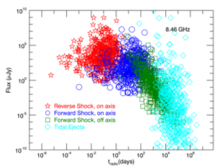
Abstract
GHz radio astronomy has played a fundamental role in the recent dazzling discovery of GW170817, a neutron star (NS)-NS merger observed in both gravitational waves (GWs) and light at all wavelengths. Here we show how the expected progress in sensitivity of ground-based GW detectors over the next decade calls for U.S.-based GHz radio arrays to be improved beyond current levels. We discuss specifically how several new scientific opportunities would emerge in multi-messenger time-domain astrophysics if a next generation GHz radio facility with sensitivity and resolution 10× better than the current Jansky Very Large Array (VLA) were to work in tandem with ground-based GW detectors. These opportunities include probing the properties, structure, and size of relativistic jets and wide-angle ejecta from NS-NS mergers, as well as unraveling the physics of their progenitors via host galaxy studies.